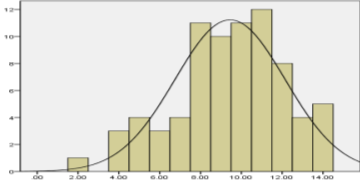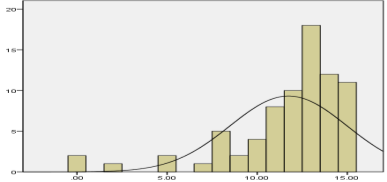By analyzing the final exam papers of Ancient Chinese in the first semester of the 2017 to 2018 school year, we can understand students' mastery of words, Chinese characters and other contents, and provide strong data and experience support for the next teaching interaction, reform and innovation.
Keywords: Ancient Chinese, final exam, teaching, innovation
In the first semester of the 2017-2018 school year, the final exam of Ancient Chinese was conducted. All 76 students took the exam. Among them, 13 boys and 63 girls accounted for 17.1% and 82.9% of the total. Through the analysis of the final exam results of Ancient Chinese, it found among the 76 test subjects, the lowest score is 38, the highest score is 90, and the average is 75.32.The relationship between the number of students and the scores as shown below:

Fig. 1. The relationship between the number of students and the scores(※The horizontal axis represent the score and the vertical axis represent the number of students)
Ancient Chinese examination paper are composed of eight questions: the first question is the choice question; the second question fill in the blank question, the third question the translation question; the fourth question noun explain; the fifth question the explanation add some words; the sixth question the short answer question; The seventh question the classification question; the eighth question the analysis question. Each problem points as follows:
Table 1
The distribution of scores of various s in Ancient Chinese test papers
|
Question score |
The numbers of student |
Total score |
Minimum |
Maximum |
Average |
|
Question 1 score |
76 |
10 |
2 |
8 |
5 |
|
Question 2 score |
76 |
10 |
1 |
10 |
7 |
|
Question 3 score |
76 |
20 |
8 |
20 |
17 |
|
Question 4 score |
76 |
15 |
0 |
15 |
12 |
|
Question 5 score |
76 |
15 |
2 |
14 |
9 |
|
Question 6 score |
76 |
10 |
2 |
10 |
9 |
|
Question 7 score |
76 |
10 |
3 |
10 |
7 |
|
Question 8 score |
76 |
10 |
0 |
10 |
9 |
As can be seen from the table, The average score of the first question accounts for half of the total score,but the other scare more than half the total score. In addition to the first and fifth questions, all the other questions have full marks. There are zero points in both the fourth and eighth questions.
Because the loss score of the first question is too much, we analyze the first questions in a separate article. The following is an analysis of the score of other questions.
1.Question 5 score
Table 2
Question 5 score
|
Score |
The numbers of student |
Percentage(%) |
|
2 |
1 |
1.3 |
|
4 |
3 |
3.9 |
|
5 |
4 |
5.3 |
|
6 |
3 |
3.9 |
|
7 |
4 |
5.3 |
|
8 |
11 |
14.5 |
|
9 |
10 |
13.2 |
|
10 |
11 |
14.5 |
|
11 |
12 |
15.8 |
|
12 |
8 |
10.5 |
|
13 |
4 |
5.3 |
|
14 |
5 |
6.6 |
|
Total |
76 |
100.0 |

Fig. 2. Question 5 score
The fifth question has a total score of 15 and is composed of 15 small items, each with 1 point. More than half of the students scored between 8 and 12 points, and no student scored 15 points. This question mainly examines students' understanding of words and expressions. The words involved include "攻、兵、施、次、孰、介、折枝、贾、舍、伏、劝、让、来、违、就"etc.
(1) Through a comprehensive analysis of the student's answer, it is found that have a very bad understanding of "折枝".and "来". Only a few students answered the meaning of "折枝" for massage. The word "来" in "贻我来牟" means wheat, and only a few students answered it correctly.
(2) Some students' understanding of the words "就""劝""介""贾""舍"needs to be strengthened. The "就"of the test question means "proximity". there was its correspondence "望"in the previous text. So "就"should be interpreted as "close". The word "劝" should be interpreted as meaning “encourage”. However, many students translate as “advice” or “admonishment” according to the translating habits of modern Chinese. It is the result of bad understanding on the similarities and differences between the ancient and modern word meanings. The current word of correspondence should be considered in the translation of "介""贾""舍". Therefore, "介"should be translated as "grass mustard" , "贾" as "price" and "舍"as "put aside".
(3) For words such as "克""兵""次""伏", students have a good answer and have a firm grasp. They can accurately translate them into semantics such as "victory", "weapons", "stationing", and "ambushing".
The fifth question is used to examine students' mastery of word explanation. Regarding the use of present-day or commonly-used meanings to freely translate ancient texts, and adopting the original glyphs only to translate literally, regardless of the differences in the shape of Chinese characters, they should be valued and avoided.
2.Question 4 score
Table 3
Question 4 score
|
Score |
The numbers of student |
Percentage(%) |
|
0 |
2 |
2.6 |
|
2 |
1 |
1.3 |
|
5 |
2 |
2.6 |
|
7 |
1 |
1.3 |
|
8 |
5 |
6.6 |
|
9 |
2 |
2.6 |
|
10 |
4 |
5.3 |
|
11 |
8 |
10.5 |
|
12 |
10 |
13.2 |
|
13 |
18 |
23.7 |
|
14 |
12 |
15.8 |
|
15 |
11 |
14.5 |
|
Total |
76 |
100.0 |

Fig. 3. Question 4 score
Question 4 has a total score of 15 points. Most students can score 11 points or more. There is less general loss, and 11 students get full marks. The title is a noun explanation problem, and the parts with a large number of missing scores are "古白话" and "约定论", which have not been fully or accurately explained.
There were 2 students who did not answer this question and scored zero points. Teachers need to correct students’ learning attitude during the teaching process, require students to review it carefully, and correct the examination mentality.
3. Question 8 score
Table 4
Question 8 score
|
Score |
The numbers of student |
Percentage(%) |
|
0 |
1 |
1.3 |
|
1 |
1 |
1.3 |
|
4 |
3 |
3.9 |
|
5 |
1 |
1.3 |
|
7 |
5 |
6.6 |
|
8 |
4 |
5.3 |
|
9 |
7 |
9.2 |
|
10 |
54 |
71.1 |
|
Total |
76 |
100.0 |
Question 8 is an analysis question, a total of 10 points. This is an open question. Students explain their personal opinions based on the given materials. It requires students to answer verbal fluency and clarity. 54 students got a perfect score, accounting for 71.1%. The reasons for the lower scores are mainly concentrated as follow:
(1) Students did not accurately grasp the given material themes for a structured analysis.
(2) The student's assignment time is unreasonable. When answering this question, it is close to the time of presentation. There is no time to answer or describe it completely.
References:
- 王力.古代汉语(第一册)[M].北京:中华书局,2015.
- 荆贵生.古代汉语习题试卷集解[M].北京:商务印书馆,2011.
- 李军,张华清.《古代汉语》学习辅导与习题集[M].济南:齐鲁书社,2006.







